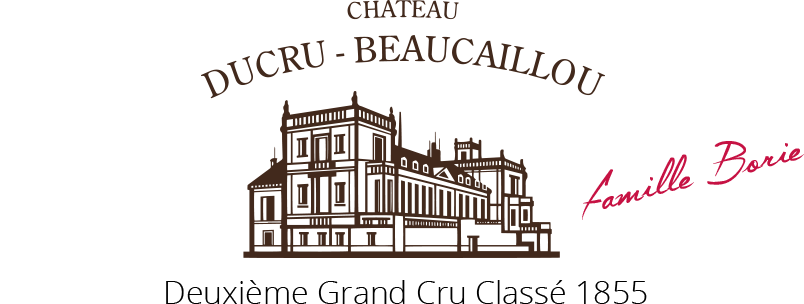
Overview
 Château Ducru-Beaucaillou is a winery in the Saint-Julien appellation of the Bordeaux region of France. Château Ducru-Beaucaillou is also the name of the red wine produced by this property.
Château Ducru-Beaucaillou is a winery in the Saint-Julien appellation of the Bordeaux region of France. Château Ducru-Beaucaillou is also the name of the red wine produced by this property.
The wine produced here was classified as one of fifteen Second Growths in the original Bordeaux Wine Official Classification of 1855. Château Ducru-Beaucaillou is named after the beautiful, large stones found in its unique wine-growing terroir. This exceptional ecosystem produces fine, elegant, tasty wines with a long finish – in short, classic Saint-Julien wines.
Perched on an exceptional site with incomparable views of the Gironde estuary in the center of a hundred-year-old park, Ducru-Beaucaillou is a majestic, Victorian-style castle. Over time, it has become one of the great symbols of the Médoc. Unusually for Bordeaux, it is built directly above the barrel cellars which envelops its owners, who have lived here for over sixty years, in the sumptuous aromas of their wine. Today, the estate is managed by the company Jean Eugène Borie SA, which is owned by Mrs. Borie, her daughter Sabine Coiffe, and her son Bruno-Eugène.
History
The history of Château Ducru-Beaucaillou is closely linked with that of the five families who have owned it and lived there since it was built in 1720. One of the 61 red Grands Crus classified as a Second Cru in the famous Bordeaux Wine Classification of 1855, it has been in the Borie family for over 60 years. Today, while many Bordeaux chateaux are owned by remote conglomerates or absent landowners, the Borie family still lives on the estate and continues to put its stamp on this highly reputed estate, with the assistance of a loyal and enthusiastic team.
The Terroir
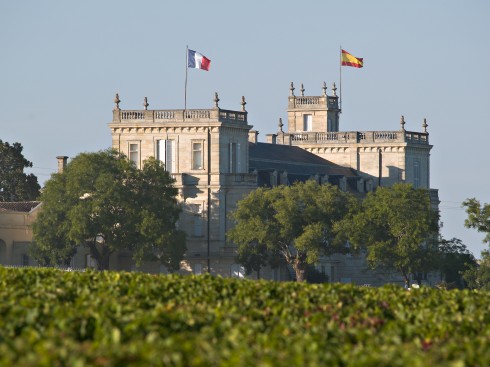 Château Ducru-Beaucaillou, whose origins lie in the early 18th century, owes its name to the “beautiful stones” that characterize its terroir and whose exceptional winemaking translates into wines with elegance and finesse. It is because of its terroir that Ducru-Beaucaillou is often considered the epitome of the Saint-Julien AOC label. It is one of the 14 Second Crus from the 1855 classification, which includes 61 of the 75 best Bordeaux wines and one of the rare wines in the “super seconds” category. Château Ducru-Beaucaillou and its vines are perched on a magnificent site in the Médoc, offering incomparable views over the Gironde estuary which, almost 4 miles wide at this point, creates its own micro-climate. It is one of the only castles in Bordeaux to be built directly of the cellars, and one of the only ones still inhabited by its owners.
Château Ducru-Beaucaillou, whose origins lie in the early 18th century, owes its name to the “beautiful stones” that characterize its terroir and whose exceptional winemaking translates into wines with elegance and finesse. It is because of its terroir that Ducru-Beaucaillou is often considered the epitome of the Saint-Julien AOC label. It is one of the 14 Second Crus from the 1855 classification, which includes 61 of the 75 best Bordeaux wines and one of the rare wines in the “super seconds” category. Château Ducru-Beaucaillou and its vines are perched on a magnificent site in the Médoc, offering incomparable views over the Gironde estuary which, almost 4 miles wide at this point, creates its own micro-climate. It is one of the only castles in Bordeaux to be built directly of the cellars, and one of the only ones still inhabited by its owners.
Ducru-Beaucaillou has belonged to the Borie family for over sixty years. They now run the estate as a limited company, with Monique Borie and her daughter Sabine Coiffe on its board and son Bruno-Eugene as CEO. The winemaking terroir of Ducru-Beaucaillou and its elevation are highly conducive to the production of fine wines. The communal terroir of Saint-Julien (800 hectares) is characterized by a layer of Garonne, or Günz gravel dating from the early Quaternary period blown by the wind from east to west, ending up as tiny white gravel stones and sand on the western side of the appellation. The 75-hectare vineyard of Ducru-Beaucaillou lies on the eastern edge of this great communal terroir.
Topographically, the vineyard of Beaucaillou starts immediately above the low-lying marshland of the Gironde, 800 meters from the estuary and extends to the west, ending at about 16 meters above sea level, a location that offers natural drainage of rainwater into the Gironde to the east or the tiny Mouline brooks to the north. There is a 6-8 meters layer of Günz Gravel deposited by the Garonne 2 millions years ago.
Advantages offered by the gravel:
- Encouraging ground drainage
- Reflecting the sun onto the closely-planted grapes
- Storing daytime heat to recycle it at night
- Forming a protective layer that stops the ground from drying out during summer heat waves and other dry periods
This gravel lies on a tertiary substratum made of Oligocene mud and deposits of Eocene limestone.
Climate: Warmer in winter, colder in summer. Near the Gironde, local winemakers are spared much frost and hailstorms.
Acreage: 75 hectares
Average Age of the Vines: 35 years old
Vine Density: 10,000 vines/hectare
Harvest: Manual
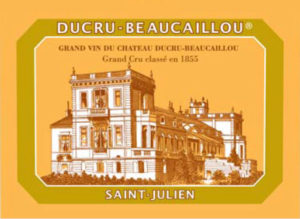
Château Ducru-Beaucaillou Saint-Julien Grand Cru Classé
Grape Varieties: Cabernet Sauvignon, Merlot
Aging: 18 months in 50-80% new barrels (French oak)
Production Area: 75 hectares
Average Age of the Vines: 35 years old
The Vines: The vineyard is planted with 70% Cabernet Sauvignon and 30% Merlot. Fertility is moderated and a root network develops (reaching up to 6 meters deep), both reducing the effect of climatic excess and increasing the take-up of nutrients from the soil and subsoil. Meticulously exploring the poor, arid soil to find the necessary nutrients and water, the roots carry back the trace elements which give the wine its uniqueness: this is the essence of the terroir of Ducru-Beaucaillou.
Plant Density: 10,000 vines per ha. This high density reduces the production of each plant while creating competition between the vines that will search deeper down into the soil to find their nutriment (“vines must suffer in order to produce”). It also generates a microclimate with many an advantage: 1) Maximizing the leaf surface per hectare and therefore the rainwater consumption which are particularly profuse in our Atlantic climate 2) Creating ideal conditions for the grapes.
Harvest: The grapes are all harvested manually. They are sorted in the vines on mobile tables to avoid contact between unhealthy and healthy grapes during transport to the vat room.
Vinification: The vinification of each plot is done individually to optimize the choice of blends. Moreover, the fermentations are carried out separately and customized to take account of terroir, grape variety, and vintage characteristics. The grapes undergo a gentle extraction and the must is kept at traditional temperatures with moderate lengths and frequencies of pumping-over. The press drains off continuously into barrels to facilitate the selection of the press-wine batches. Malolactic fermentation is managed in vats for optimal control. The wine is barreled in duly identified individual batches immediately after malolactic fermentation. Blending takes place during the first racking operation; for Ducru Beaucaillou, between 50 and 80% of new barrels are used according to the richness of the vintage. The barrels (225L Bordeaux barrels, French oak) are supplied by 5 carefully selected cooperages giving every guarantee.
Aging: The wine is matured for 18 months in accordance with Medoc traditions for classified growths. Bottling is performed with special care in regard to both oenological controls and homogenisation of the overall batch. The 5 cork makers supplying the estate have signed a detailed and stringent quality charter.
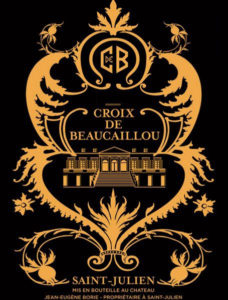
Croix de Beaucaillou
Overview: This is the second wine of Château Ducru-Beaucaillou. La Croix de Beaucaillou is produced from the same vineyard as the first wine.
Harvest: The grapes are all harvested manually. They are sorted in the vines on mobile tables to avoid contact between unhealthy and healthy grapes during transport to the vat room.
Vinification: The vinification of each plot is done individually to optimize the choice of blends. Moreover, the fermentations are carried out separately and customized to take account of terroir, grape variety and vintage characteristics. Extraction is gentle and the must is kept at traditional temperatures with moderate lengths and frequent pumping-over. The press drains off continuously into barrels to facilitate the selection of the press-wine batches. Malolactic fermentation is managed in vats for optimal control. The wine is barreled in individual batches immediately after malolactic fermentation. Blending takes place during the first racking operation; for La Croix de Beaucaillou, between 20-40% of new wood is used depending on the richness of the vintage. The barrels (225L Bordeaux barrels, French oak) are supplied by 5 carefully selected cooperages.
Aging: The wine is matured for 12 months. Bottling is performed with special care in regard to both oenological controls and homogenization of the overall batch. The 5 cork makers supplying the estate have signed a detailed and stringent quality charter.

Le Petit Ducru De Ducru Beaucaillou Saint-Julien
Overview: This newcomer is a selection derived from the St-Julien vineyards. An affectionate and informative name that already tells wine lovers something about its positioning and its ambitions.
Le Petit Ducru portends an introduction to the Borie signature, a courteous invitation to approach the qualities of its elders, Ducru-Beaucaillou and La Croix Ducru-Beaucaillou; from its complexity to its structure, by way of its balance and its elegance. There is, of course, a family resemblance, a wonderful complicity between the three nectars. They know what they have in common: a rigorous technical process, drastic selection, demanding winemaking.
A nod also to the history of the estate, specifically to one of the former owners, Bertrand Ducru (1770-1829), a brilliant and worldly merchant from the Bearn region of France, situated along the flanks of the western Pyrenees mountains. Powerful and well established, he bought the property in 1797 (16 Vendémiaire, year 6) and added his surname to that of the site, which then became “Ducru-Beaucaillou”. He hired the architect, Paul Abadie, graduate of the acclaimed Ecole des Beaux-Arts de Paris, to enhance the elegant Directory-period chartreuse. But above all, he invested heavily in the vineyards and the cellar. The wines quickly rose to the summit of the appellation and Ducru-Beaucaillou obtained unanimous recognition from the Place de Bordeaux, which later consecrated it with a place in the 1855 classification.
Grape Varieties: A Cabernet-Merlot blend and depending on the vintage, sometimes with a hint of Petit Verdot, varietal that we know to be a skillful sculptor.
Aging: Barrel aging lasts for 12 months with one-third new oak.
Tasting Notes: Le Petit Ducru is a wine of balance and harmony. An elixir of youth. It is there, alive and well, a rendezvous with pleasure. Accessible from its earliest youth, uninhibited in its Chaplinesque antics. It will make for a happy dining companion in restaurants. It will make for a perfect marriage with poultry where it will bow down before its crispy, brown skin and envelop the steaming flesh with its tannins.
Le Petit Ducru tastes of Sundays. Above all, it tastes of friendship.
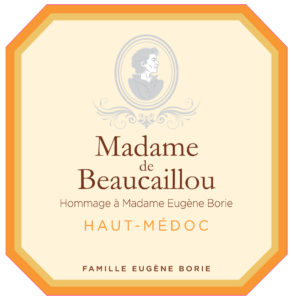
Madame de Beaucaillou Haut-Médoc
Overview: This new wine comes from vineyards located in Haut-Médoc; plots brought by Madame Eugène-Borie on her marriage and more recently by the acquisition of plots from Madame Fort-Pradère. A tribute to the woman who chaired the Supervisory Board from 1998 until 2020, but also to an attentive and loving mother. To the muse too. The opportunity to put the spotlight on this great lady who, out of discretion and humility, was content to stay in the shadows. Gently, calmly, her image will join the long line of female owners of Ducru-Beaucaillou, equally inspiring and demanding: Marie Desjean, Marie du Luc Ravez, Lucie-Caroline Johnston, Princesse Marie Karadja de Constantinople, Mary de Burke… All of them had an essential role in the rise to fame of Ducru-Beaucaillou. Strength and grace…
Vinified by the Ducru-Beaucaillou SA teams, this wine receives the best care: the technical winemaking process, very selective blending, and careful aging for 12 months in barrel (including 20% new oak). Technique at the service of purity of expression. Merlot and Cabernet Sauvignon rub shoulders without ever competing; one brings opulence, the other brings structure. In blends, as in marriage, it is complementarity, mutual exaltation that counts.
Grape Varieties: Merlot Noir, Cabernet Sauvignon, Petit Verdot, Cabernet Franc
Alcohol: 14.0%
Aging: 12 months in Bordeaux barrels, 20% in new oak and the balance in one-year barrels (twelve months). The oak is of certified French origin, naturally dried outdoors for a guaranteed minimum of three years. Regular topping-up during the first six months, racking every two or three months with a total of four rackings. Sterile bottling under inert gas take place in June/July 2021. 49 mm natural cork.
Cellar Master Tasting Notes: “Colour: bright, deep, purple. Nose: very charming and refined. Fresh, fruity, underpinned by a note of French oak, Morello cherry jam, violet. Spicy notes on aeration. Palate: clean attack, silky tannins. A pleasurable wine, delicious, subtle and seductive. Beautiful harmony and elegant femininity.”


